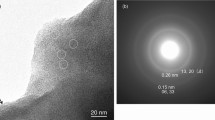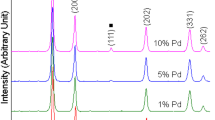Abstract
The biomolecule–inorganic hybrid materials are potential candidates for low infrared emissivity materials due to the combined functionalities of the biomolecules and the inorganic components. In this study, we describe a facile approach to fabricate DNA/layered double hydroxides (LDHs) nanohybrid by coassembly of exfoliated Ni–In LDHs nanosheets with DNA. In the assembly progress, exfoliated LDHs nanosheets and DNA with different initial DNA/LDHs mass ratio were mixed together, and the DNA intercalated LDHs nanohybrid was obtained only when the input DNA/LDHs mass ratio is ≤0.3 mg/mg. The structure and morphology of as-fabricated hybrid materials were characterized by X-ray diffraction (XRD), UV–Vis absorption spectra, Fourier transform infrared (FT-IR) spectra, thermogravimetry (TG), scanning electron microscopy (SEM), and transmission electron microscopy (TEM). The results indicate that the reassembled product has layered structures incorporated with DNA biomolecule. The nanohybrid with expanding LDHs structure of d 003 = 2.6 nm confirms the intercalation of DNA molecules into the LDHs interlayer. The helix chain oriented parallel to the basal plane of host layer forming ordered sandwich structure. The infrared emissivity value of the DNA/LDHs nanohybrid was then investigated. It was found that the infrared emissivity values were significantly reduced by coassembly of exfoliated LDHs nanosheets with DNA, which may be attributed to the synergistic effect and interfacial interaction between the DNA biomolecule and inorganic LDHs layers reinforced by the construction of ordered sandwich structure.







Similar content being viewed by others
References
Liu R, Ji C, Mock J et al (2009) Broadband ground-plane cloak. Science 323:366–369
Chou KS, Lu YC (2007) The application of nanosized silver colloids in far infrared low-emissive coating. Thin Solid Films 515:7217–7221
Chen L, Lu C, Fang Z et al (2013) Infrared emissivity and microwave absorption property of Sm0.5Sr0.5CoO3 perovskites decorated with carbon nanotubes. Mater Lett 93:308–311
Su X, Liu X, Jia Y et al (2013) Effect of synthesized temperature on microstructure, infrared emissivity and dielectric property of Fe-doped ZnO powder. J Mater Sci Mater Electron 24:4974–4979
Sun K, Zhou W, Tang X et al (2012) Effects of air annealing on the structure, resistivity, infrared emissivity and transmission of indium tin oxide films. Surf Coat Technol 206:4095–4098
Bu X, Zhou Y, He M et al (2014) Fabrication and characterization of optically active polyacetylene@WO3 nanorod hybrids with low infrared emissivity. Mater Lett 120:239–242
Zhang W, Xu G, Ding R et al (2013) Microstructure, optimum pigment content and low infrared emissivity of polyurethane/Ag composite coatings. Phys B 422:36–39
Zhang W, Xu G, Ding R et al (2013) Nacre biomimetic design—a possible approach to prepare low infrared emissivity composite coatings. Mater Sci Eng C 33:99–102
Fu LS, Jiang JT, Zhen L et al (2013) FeNi3/indium tin oxide (ITO) composite nanoparticles with excellent microwave absorption performance and low infrared emissivity. Mater Sci Eng B 178:225–230
Yan X, Xu G (2012) Influence of silane coupling agent on corrosion-resistant property in low infrared emissivity Cu/polyurethane coating. Prog Org Coat 73:232–238
Ye X, Zhou Y, Sun Y et al (2008) Structure and infrared emissivity of collagen/SiO2 composite. Appl Surf Sci 254:5975–5980
Sun Y, Zhou Y, Ye X et al (2008) Fabrication and infrared emissivity study of hybrid materials based on immobilization of collagen onto exfoliated LDH. Mater Lett 62:2943–2946
Cao Y, Zhou YM, Shan Y et al (2005) Preparation and characterization of grafted collagen confined in mesoporous silica. Chin J Inorg Chem 21:331–336
Zhu Y, Zhou Y, Zhang T et al (2012) Preparation and characterization of lactate-intercalated Co–Fe layered double hydroxides and exfoliated nanosheet film with low infrared emissivity. Appl Surf Sci 263:132–138
Wang Y, Zhou Y, Zhang T et al (2014) Acetate-intercalated Ni–In layered double hydroxides with low infrared emissivity: synthesis, delamination and restacked to form the multilayer films. Appl Surf Sci 288:710–717
Evans D, Slade R (2006) Structural aspects of layered double hydroxides layered double hydroxides. Springer, Berlin, pp 1–87
Choy JH, Kwak SY, Park JS et al (1999) Intercalative nanohybrids of nucleoside monophosphates and DNA in layered metal hydroxide. J Am Chem Soc 121:1399–1400
Chen X, Fu C, Wang Y et al (2008) Direct electrochemistry and electrocatalysis based on a film of horseradish peroxidase intercalated into Ni–Al layered double hydroxide nanosheets. Biosens Bioelectron 24:356–361
An Z, Lu S, He J et al (2009) Colloidal assembly of proteins with delaminated lamellas of layered metal hydroxide. Langmuir 25:10704–10710
Charradi K, Forano C, Prevot V et al (2010) Characterization of hemoglobin immobilized in MgAl-layered double hydroxides by the coprecipitation method. Langmuir 26:9997–10004
Yang Y, Zhou Y, Ge J et al (2011) Synthesis, characterization and infrared emissivity property of optically active polyurethane derived from tyrosine. Polymer 52:3745–3751
Yasutake A, Aisawa S, Takahashi S et al (2008) Synthesis of biopolymer intercalated inorganic-layered materials: intercalation of collagen peptide and soybean peptide into Zn–Al layered double hydroxide and layered zinc hydroxide. J Phys Chem Solids 69:1542–1546
Choy JH, Kwak SY, Jeong YJ et al (2000) Inorganic layered double hydroxides as nonviral vectors. Angew Chem Int Ed 39:4041–4045
Hibino T, Jones W (2001) New approach to the delamination of layered double hydroxides. J Mater Chem 11:1321–1323
Rives V (2001) Layered double hydroxides: present and future. Nova Science Publication, New York
Khan AI, O’Hare D (2002) Intercalation chemistry of layered double hydroxides: recent developments and applications. J Mater Chem 12:3191–3198
Xu ZP, Braterman PS (2003) High affinity of dodecylbenzene sulfonate for layered double hydroxide and resulting morphological changes. J Mater Chem 13:268–273
Nakamoto K (2006) Infrared and Raman spectra of inorganic and coordination compounds. Wiley, New Jersey
Wang Z, Zhou Y, Sun Y (2010) Helical polyurethane-imide@attapulgite composite: preparation, characterization and infrared emissivity study. Mater Lett 64:908–911
Acknowledgements
The authors are grateful to the National Nature Science Foundation of China (51077013), the Innovation Research Foundation of College Graduate Jiangsu Province (CXLX12-0106), and Fund Project for Transformation of Scientific Technological Achievement of Jiangsu Province of China (BA2011086) for financial support.
Author information
Authors and Affiliations
Corresponding author
Rights and permissions
About this article
Cite this article
Wang, Y., Zhou, Y., Zhang, T. et al. Coassembly of exfoliated Ni–In LDHs nanosheets with DNA and infrared emissivity study. J Mater Sci 49, 6944–6951 (2014). https://doi.org/10.1007/s10853-014-8399-5
Received:
Accepted:
Published:
Issue Date:
DOI: https://doi.org/10.1007/s10853-014-8399-5




